KFF Health Tracking Poll – May 2020
Coronavirus And U.s. Politics
Key Findings:
- Most Americans expect the coronavirus to upend summer vacation plans with few saying it is likely they will be staying in a hotel (32%), going on an airplane (23%), or going to a concert or sporting event (19%) in the next 3 months. Yet, majorities including most Republicans and independents, expect to be getting back to some usual activities in the coming months such as going to the doctor, going to a barber or salon, attending larger gatherings, or eating in a restaurant. Most Democrats say it is unlikely they will be doing any of these activities except for going to a doctor or health care provider.
- In the midst of the coronavirus outbreak, the economy and health care rank solidly as the top two issues in the 2020 presidential election, with all other issues trailing far behind for voters. Yet, the issue most important to voters is largely driven by party identification. Four in ten Republican voters say the economy is their top voting issue while one-third of Democratic voters (32%) choose health care as the most important issue in their voting decision. The coronavirus outbreak itself ranks as among the top issues among Democratic voters (29%), but ranks as the third issue among total voters (17 percent) and swing voters (19 percent).
- President Trump receives negative ratings on his job performance and handling of coronavirus and health care, but the public does not seem to be punishing him for the decline in the nation’s economy as a result of the coronavirus outbreak. A majority of the public (57%) and the crucial block of undecided voters known as “swing voters” (59%) continue to approve of President Trump’s handling of the nation’s economy. President Trump remains largely popular among Republicans with majorities approve of his handling of all national issues.
- Democrats are almost twice as likely as Republicans (70% v. 37%) to say they wear a mask “every time” they leave their house and while most people (72%) think President Trump should wear a mask when meeting with other people, only about half of Republicans (48%) agree. The partisan difference in opinion and behavior regarding masks is largely driven by Republican men. About half of Republican men report wearing a protective mask at least most of the time when leaving their house to go someplace where they may come into contact with others (49%) and smaller shares say President Trump should wear a mask when meeting with other people (43%).
As Many States Are Re-Opening, Most U.S. Residents Don’t Expect To Get Back To Normal Soon
The coronavirus outbreak has had widespread effects across the U.S. bringing most Americans’ lives to a halt for the past couple months. But as states begin to re-open, Democrats and Republicans hold very different views of what the future holds. Most Republicans say the worst of the coronavirus is behind us or that the virus was never a threat, and they are likely to go back to usual activities in the coming months. Democrats, and to some extent independents, are more wary of the future and don’t think it is likely that their lives will be back to normal in the coming months.
Overall, half of U.S. adults still say that “the worst is yet to come” when it comes to the coronavirus outbreak in the U.S., which is considerably larger than the share (28%) who say “the worst is behind us.” The share who say “the worst is yet to come” remains relatively unchanged since last month’s KFF Health Tracking Poll, and the partisan divide remains. This month finds two-thirds of Republicans saying either “the worst is behind us” (45%) or that they don’t think the coronavirus is or was a major problem in the U.S. (20%).On the other hand, most Democrats (70%) and half of independents say “the worst is yet to come.”
Larger Shares of Republicans Report Going Back to Usual Activities
Most think that it is at least somewhat likely that they will resume some usual activities within the next three months, such as going to a dental or medical appointment in person (82%), attending gatherings with more than 10 people (58%), going to a barber or salon (56%), and eating in person at a restaurant (53%). Yet, while next week marks the official beginning to summer with observance of Memorial Day, few think it is “likely” they will be doing many typical summer activities such as staying at a hotel or vacation rental (32%), flying in an airplane (23%), or attending a concert or sporting event (19%) in the coming months.
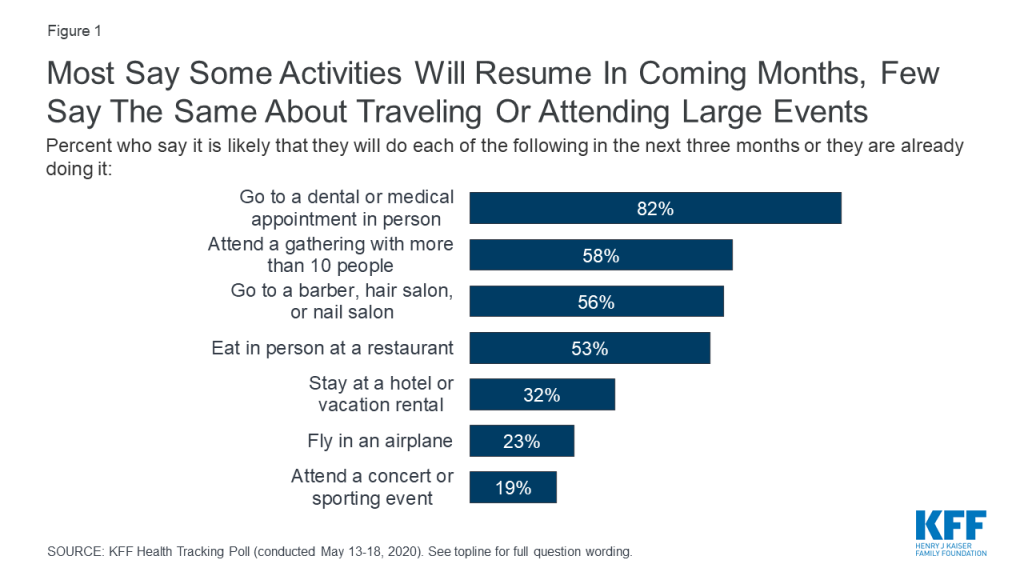
Majorities of Democrats (79%), independents (83%), and Republicans (91%) say it is likely they will go to a doctor, dentist, or other medical appointment in person in the next three months; but less than half of Democrats say the same about going to a barber or salon (43%), attending larger gatherings (43%), or eating in person at a restaurant (39%). Majorities of Republicans and independents say they are either already doing these activities or it is likely they will do them in the next three months.
Few – across party identification- say it is likely they will stay at a hotel or vacation rental, fly in an airplane, or attend a concert or sporting event in the coming months.
| Table 1: Partisans Disagree On How Likely It Is They Will Be Back To Usual Activities | |||
| Percent who say it is likely they will do the following in the next three months or are already doing the following: | Party Identification | ||
| Democrats | Independents | Republicans | |
| Go to a doctor, dentist, or other medical appointment in person | 79% | 83% | 91% |
| Go to a barber, hair salon, or nail salon | 43 | 55 | 74 |
| Attend a gathering of family or friends with more than 10 people | 43 | 58 | 73 |
| Eat in person at a restaurant | 39 | 52 | 75 |
| Stay at a hotel or vacation rental | 24 | 31 | 43 |
| Fly in an airplane | 21 | 25 | 25 |
| Attend a concert or sporting event | 8 | 20 | 31 |
Is Your State Opening Too Soon? Depends On Where You Live
About half of adults – across party identification – say they think their state is moving at about the right speed in easing social distancing restrictions and opening businesses while one in four (27%) say their state is moving “too quickly” and one in five (21%) say their state is opening “too slowly.”
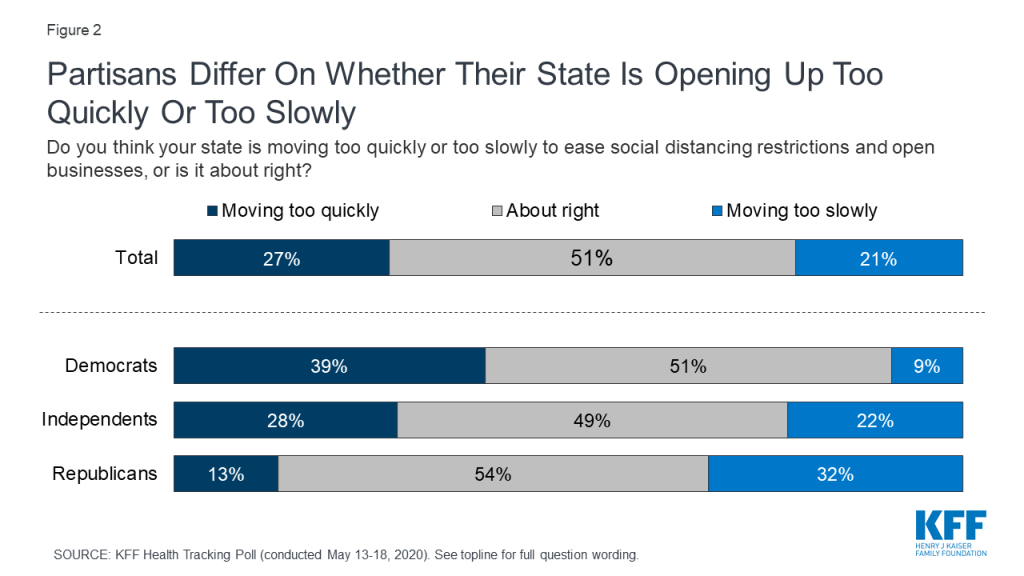
More than three times as many Republicans (32%) as Democrats (9%) say their state is opening “too slowly,” and one-fifth (22%) of independent say the same. Four in ten Democrats (39%) say their state is opening “too quickly” compared to 28% of independents and 13% of Republicans. About half, across party lines, say their state is doing things “about right.”
With all U.S. states taking some steps to re-open their economies, some states – most notably those with Republican governors like Texas and Arizona – have pushed to re-open their states sooner than many public health officials have advised. About four in ten (37%) of those living in states with a Republican governor say their state is moving “too quickly” compared to one in five of those living in states with a Democratic governor.
There are strong party divides with partisans more likely to support their state’s actions if their governor shares their party identification. Nearly two-thirds (64%) of Republicans living in a state with a Republican governor saying their state is doing things “about right,” while most Democrats (62%) and a slight majority of independents (51%) living in states with a Democratic governor saying their state is doing things at about the right speed.
| Table 2: Partisans Living In Republican-Led States Have Different Views On Whether Their State Is Re-Opening Too Quickly Or Too Slowly | ||||
| Do you think your state is moving too quickly or too slowly to ease social distancing restrictions and open businesses, or is it about right? | Living in a state with a Republican Governor | |||
| Total | Democrats | Independents | Republicans | |
| Too quickly | 37% | 56% | 40% | 16% |
| Too slowly | 15 | 9 | 15 | 20 |
| About right | 47 | 34 | 44 | 64 |
| Do you think your state is moving too quickly or too slowly to ease social distancing restrictions and open businesses, or is it about right? | Living in a state with a Democratic Governor | |||
| Total | Democrats | Independents | Republicans | |
| Too quickly | 20% | 27% | 19% | 11% |
| Too slowly | 26 | 9 | 28 | 45 |
| About right | 52 | 62 | 51 | 43 |
Amidst Outbreak, Republican Voters Say Economy Is Top 2020 Issue While Health Care And Coronavirus Weighs Heavily On Democratic Voters
With less than six months before the 2020 presidential election, partisan voters are prioritizing different issues with the economy and health care rising to the top. Overall, both the economy (25%) and health care (23%) are the top issues for voters when deciding their vote for president in November. These two issues outrank all other issues including the coronavirus outbreak (17%), foreign policy and national security (10%), climate change (6%), immigration (6%), and taxes (5%).
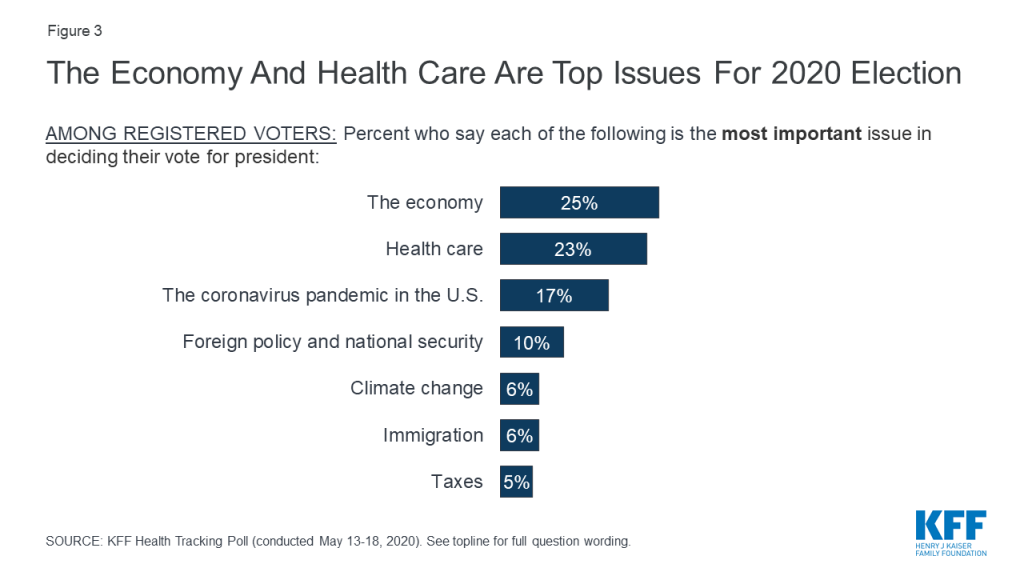
Throughout the 2020 Democratic presidential primary, Democratic voters said health care was their most important issue. In fact, in all of the 17 states in which KFF has analyzed AP VoteCast survey data of primary voters and caucus-goers, health care was either the top issue (15 states), or among the top issues (2 states). Health care remains a top issue for Democratic voters with one-third (32%) choosing health care as the most important issue to their vote decision, followed closely by the coronavirus pandemic in the U.S. (29%). Fewer Democratic voters (13%) say the economy is the most important issue. Republican voters, on the other hand, are prioritizing the economy over all other issues with four in ten saying it is “the most important issue” followed by foreign policy and national security (18%). Fewer Republican voters say either health care (11%) or coronavirus (6%) is the most important issue to their vote. Independents are split with similar shares prioritizing health care (25%) and the economy (25%).
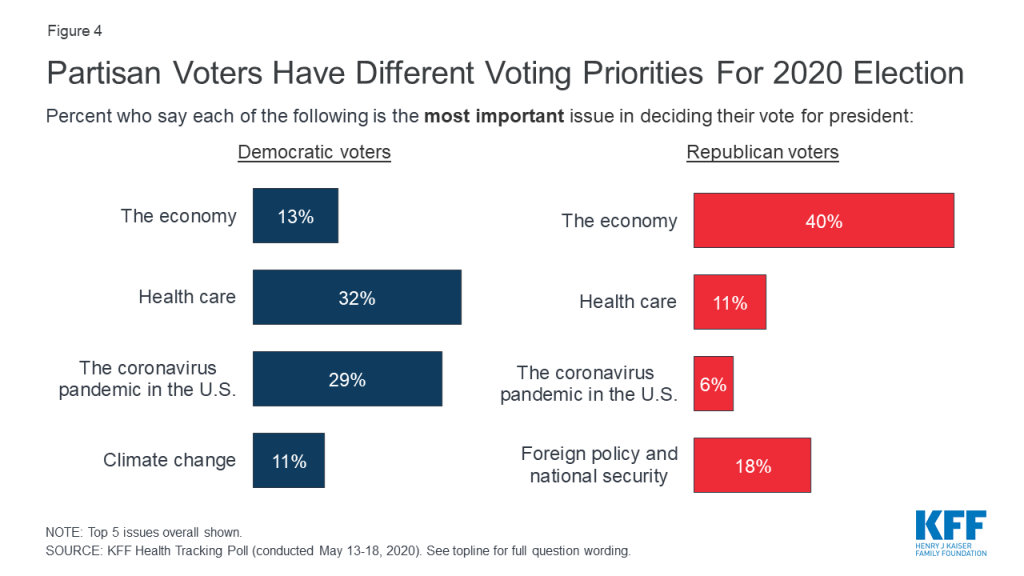
Swing Voters Say Issues, Not Trump, Will Drive Their 2020 Decision
With former Vice President Joe Biden now the presumptive nominee for the Democratic candidate for president, the latest KFF Health Tracking Poll examines the views of voters who have not yet made up their minds about who to vote for.
Defining Swing Voters
A similar share of voters say they are either “definitely going to vote for President Trump” (30%) as say they are “definitely going to vote for Joe Biden” (28%), while nearly four in ten voters either say they are undecided in their 2020 vote choice (11%) or are probably going to vote for President Trump (11%) or Democratic nominee Joe Biden (15%) but have not made up their minds yet.
Swing voters are more likely than voters, overall, as well as voters across party identification to say their vote for president will “mostly be based on the candidates’ position on the issues” (75%) rather than based on “how they feel about President Trump” (21%).
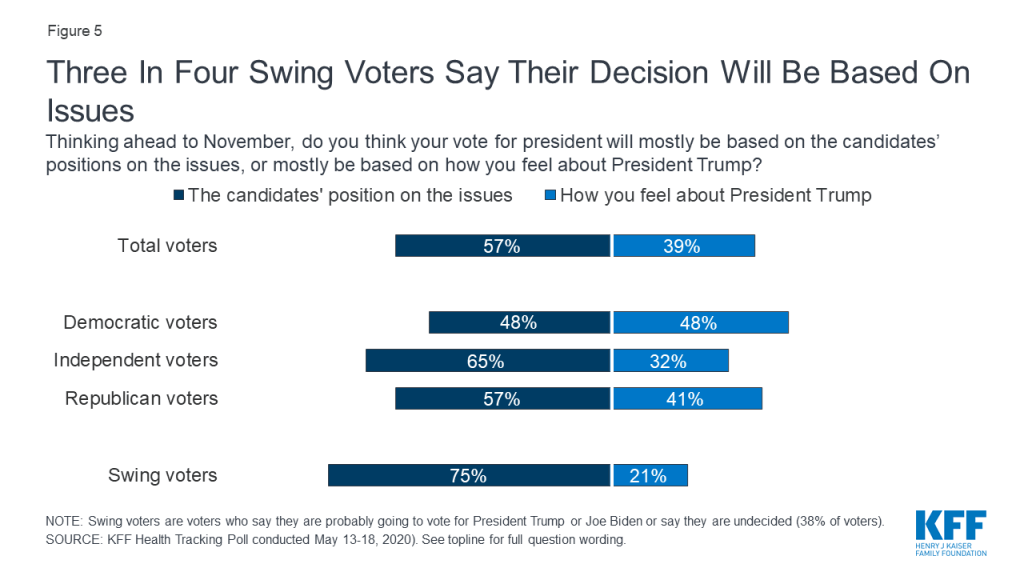
Swing voters’ priorities in their 2020 vote choice are similar to the rankings among all voters, with three in ten swing voters saying health care is their top issue and one-fourth choosing the economy as their top issue. About one in five (19%) say the coronavirus pandemic in the U.S. is the most important issue in deciding their vote.
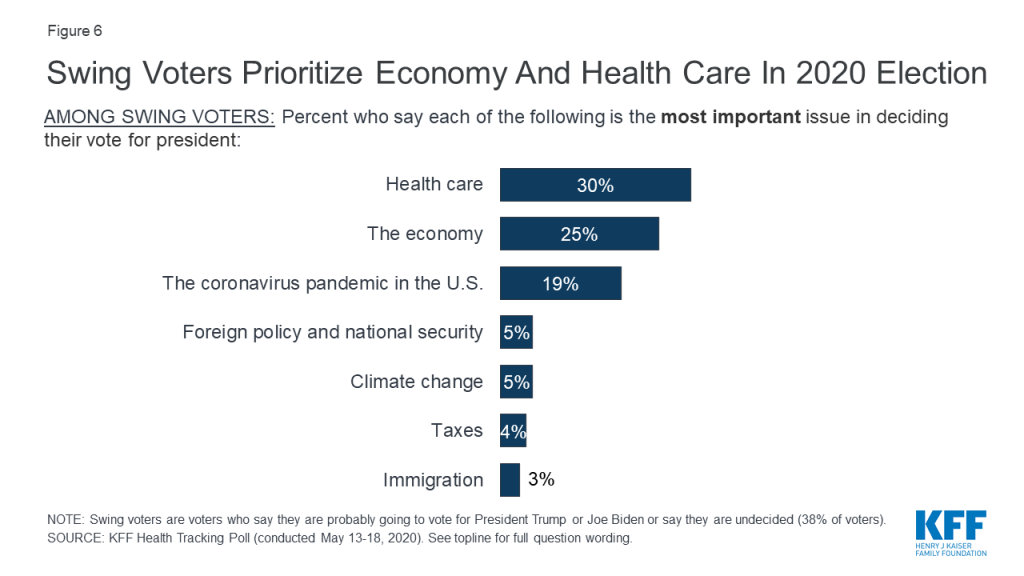
Is Trump’s Handling of Coronavirus Impacting Voters’ 2020 Decision?
Nearly one in five voters overall (17%) and three in ten Democratic voters (28%) say the coronavirus pandemic in the U.S. is going to be “the most important issue” when deciding their vote for president. When voters who said coronavirus was going to be very important to their vote are asked to say in their own words what about the outbreak is going to impact their vote, larger shares offer negative responses about President Trump’s handling of the virus than any other response. About one-third of voters who say coronavirus is important to their vote (16% of all voters) offer responses related to President Trump’s poor leadership, four times as many who offer any other response including the impact on the economy and jobs (3% of all voters). An additional one in ten (11%) mention general responses related to the handling of the outbreak.
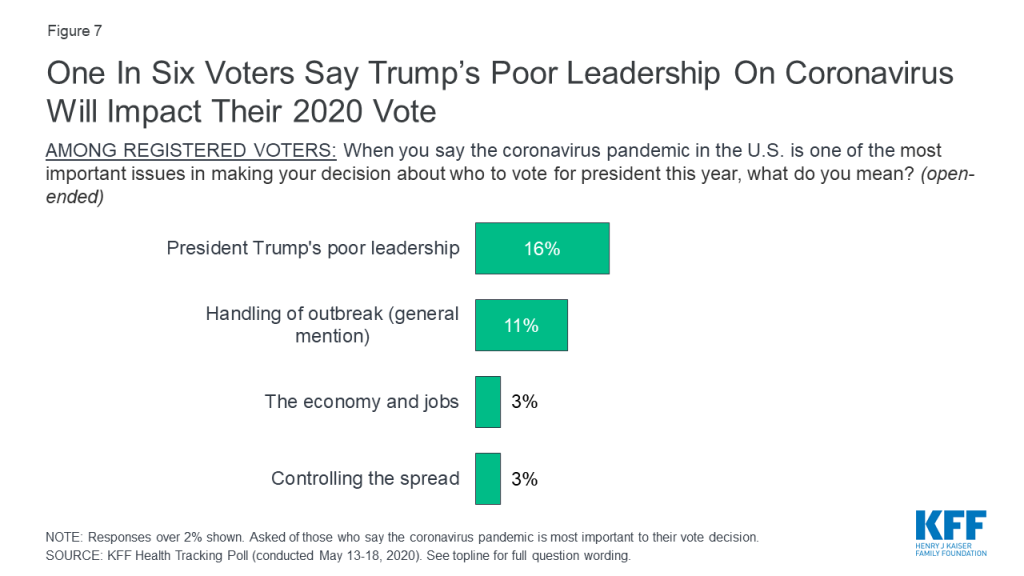
This is consistent with how the public rate the job President Trump is doing with the current coronavirus outbreak in the U.S. President Trump now receives negative ratings for his handling of the coronavirus outbreak with a slightly smaller share approving (46%) than disapproving (52%) of his handling of this issue (-6 percentage points net approval). This marks a decline in the public’s evaluation of his handling of the coronavirus outbreak from six weeks ago when 50% of the public approved of his response and he had a net positive rating (+3 percentage points net approval).
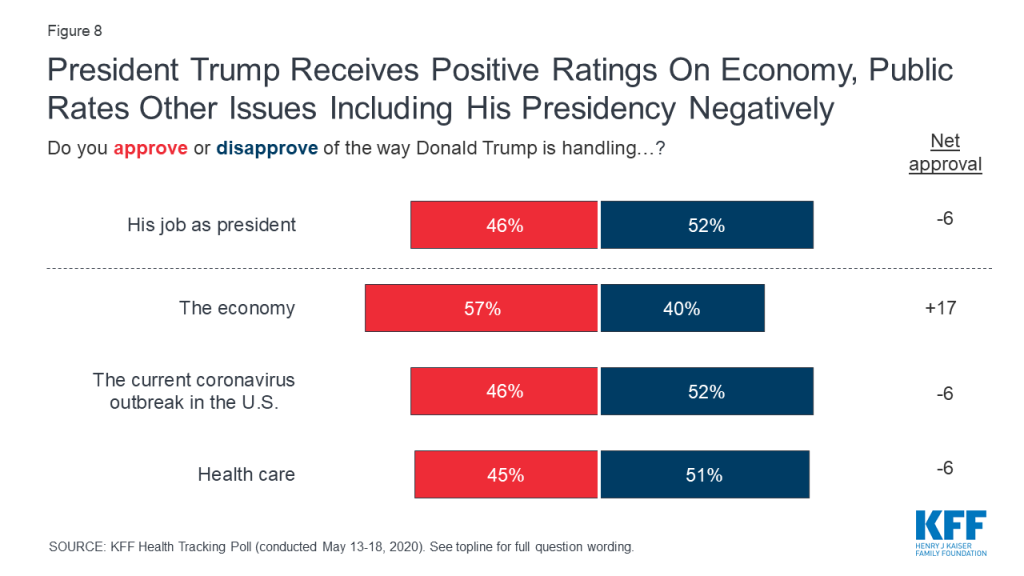
Even among the largest job loss in recent history and economists’ warning about long-term unemployment, President Trump continues to receive positive ratings in his handling of the economy (+17 percentage points net approval).
Partisans continue to be strongly divided in their assessment of President Trump’s job performance, with at least eight in ten Republicans approving of the way he is handling the economy (91%), his job as president (89%), the current coronavirus outbreak in the U.S. (87%), and health care (84%). Democrats, on the other hand, largely disapprove of his job as president (87%), as well as the way he is handling health care (86%), the current coronavirus outbreak (84%), and the economy (71%). Independents are divided in their assessments of his job performance overall but give him negative assessments on his job approval overall (-10 percentage point net approval), as well as his handling of health care (-10 percentage point net approval) and the current coronavirus outbreak (-6 percentage point net approval), but positive ratings on his handling of the economy (+20 percentage point net approval).
| Table 3: President Trump Job Approval By Party Identification | ||||
| Do you approve or disapprove of the way Donald Trump is handling…? | Party ID | |||
| Democrats | Independents | Republicans | ||
| His job as president | Approve | 12% | 44% | 89% |
| Disapprove | 87 | 54 | 10 | |
| The economy | Approve | 25 | 59 | 91 |
| Disapprove | 71 | 39 | 9 | |
| Health care | Approve | 12 | 41 | 84 |
| Disapprove | 86 | 51 | 12 | |
| The current coronavirus outbreak in the U.S. | Approve | 15 | 46 | 87 |
| Disapprove | 84 | 52 | 12 | |
Swing voters are also negative in their assessments of President Trump’s presidency and his handling of most national issues. Swing voters (who comprise 38% of all voters) largely disapprove (59%) of the way President Trump is handling his presidency and are also negative in Trump’s handling of both the coronavirus outbreak (-24 percentage point net approval) and health care (-21 percentage point net approval). Swing voters, like the overall public, remain positive in their assessments of his handling of the economy (+19 percentage point net approval).
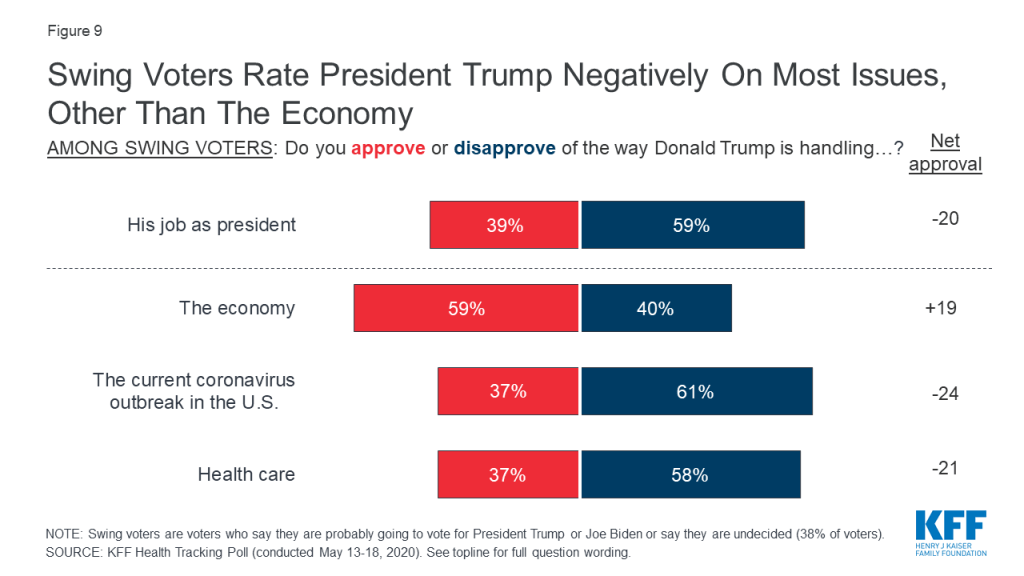
Is The Use Of Masks Partisan?
Three-fourths (74%) of adults say they wear a protective mask either “every time” or “most of the time” when they leave their house and might be in contact with people, which is consistent with the Centers for Disease Control and Prevention (CDC) recommendations that people wear a mask anytime they may be unable to maintain safe social distancing. But there are strong partisan differences with Democrats almost twice as likely as Republicans (70% v. 37%) to say they wear a mask “every time” they leave their house. Majorities across partisans say they wear a mask at least most of the time.
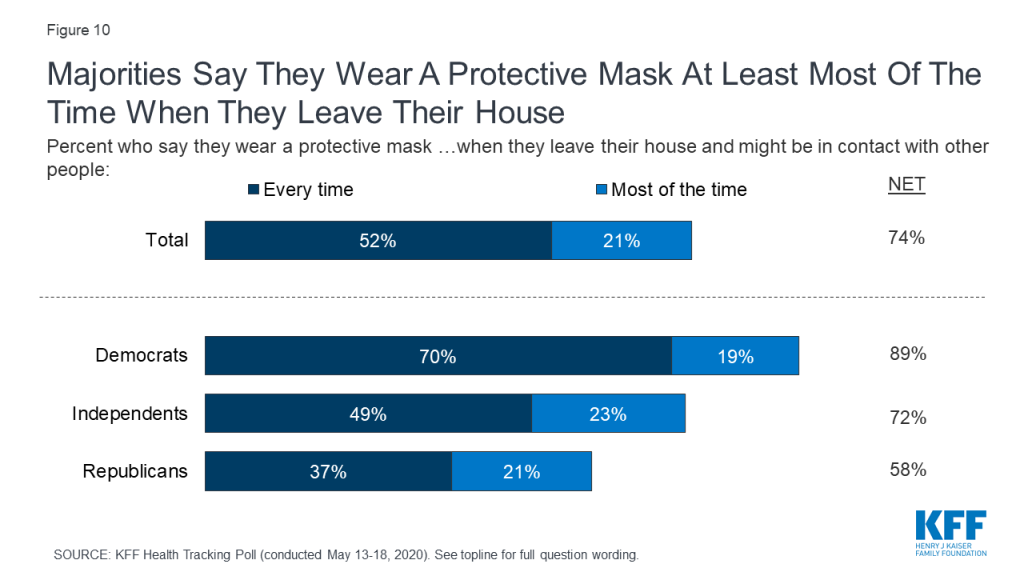
There have been recent news reports about people protesting the requirement of wearing masks in order to limit contact and reduce the spread of coronavirus including some recent criticism of President Trump for not wearing a mask when making public appearances. Most people (72%) think President Trump should wear a mask when meeting with other people, but only about half of Republicans (48%) agree.
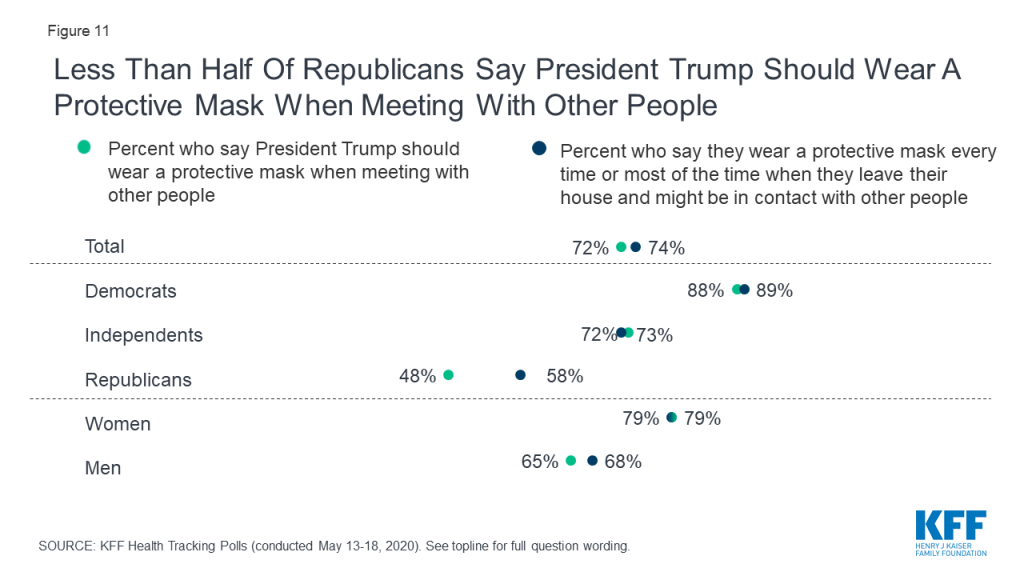
The partisan difference in opinion and behavior regarding masks is largely driven by Republican men. Republican men are both less likely to report wearing a protective mask when leaving their house to go someplace where they may come into contact with others and smaller shares say President Trump should wear a mask when meeting with other people. About half (49%) of Republican men say they wear a mask at least most of the time, compared to 68% of Republican women and more than two-thirds of independent men (68%) and a large majority of Democratic men (89%). Slightly more than four in ten Republican men (43%) say President Trump should wear a mask compared to 53% of Republican women, and large majorities of both independent men (67%) and Democratic men (83%).
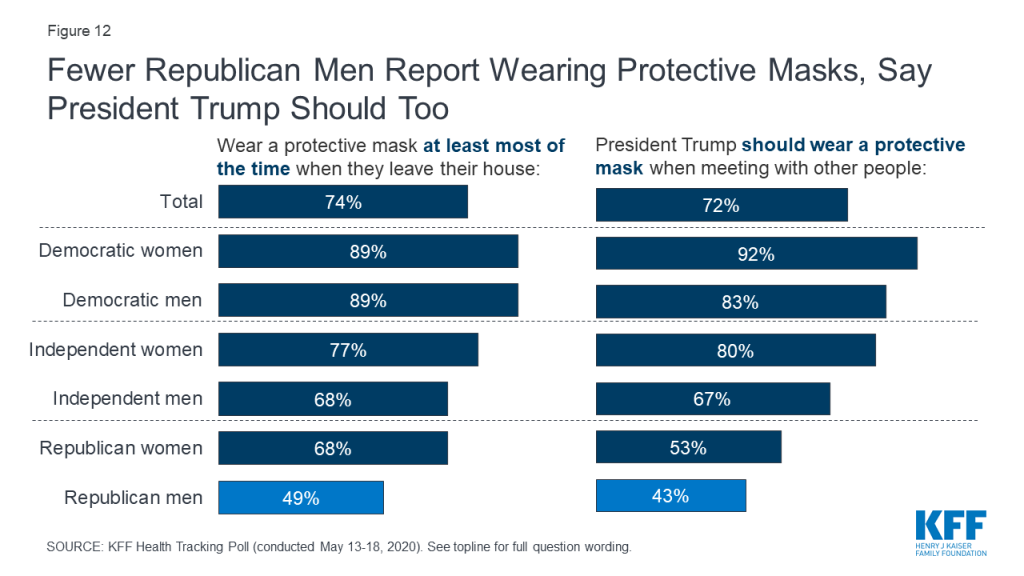
Health And Economic Impacts
Impact of Coronavirus on Personal Health,Economic and Food Security, and Medicaid
Key Findings:
- Amidst the coronavirus pandemic, Americans are deferring medical care. Nearly half of adults (48%) say they or someone in their household have postponed or skipped medical care due to the coronavirus outbreak. However, as stay-at-home restrictions ease, most (68% of those who delayed care, or 32% of all adults) expect to get the delayed care in the next three months.
- About four in ten U.S. adults (39%) say worry or stress related to coronavirus has had a negative impact on their mental health, including 12% who say it has had a “major” impact. This is down slightly from early April when 45% reported a negative mental health impact. Yet, women continue to be more likely than men to say it is has negatively impacted their mental health (46% vs 33%) and urban (46%) and suburban (38%) residents are more likely than those in rural areas (28%) to say coronavirus has had a negative impact on their mental health. Among adults in households that experienced income or job loss due to the coronavirus outbreak (who make up one-third of adults overall), 46% say the pandemic has had a negative impact on their mental health.
- Three in ten adults (31%) say they have fallen behind in paying bills or had problems affording household expenses like food or health insurance coverage since February due to the coronavirus outbreak. Additionally, one in four Americans (26%) say they or someone in their household have skipped meals or relied on charity or government food programs since February, including 16% who say this was due to the impact of coronavirus on their finances. The share who say they have skipped meals or relied on charity or government food programs due to coronavirus is higher among those in households that have lost a job or income due to coronavirus (30%) and among Black adults (30%) and Latinos (26%).
- As states consider spending cuts to address budget shortfalls caused or exacerbated by the coronavirus pandemic, it appears that many potential cuts will be unpopular among the public. At least three-quarters of adults oppose decreasing spending on K-12 public education (80%), police and safety (75%), and Medicaid (74%). Moreover, majorities oppose cutting spending on social services (60%), higher education (55%), prisons and jails (54%), and environmental protection (53%). Transportation is the only area which garners majority support for state budget cuts. Majorities of Democrats (85%), independents (73%), and Republicans (62%) oppose their state government decreasing spending on Medicaid.
- At a time when many newly unemployed Americans may turn to Medicaid for health insurance coverage, a majority of adults (55%) say the Medicaid program is personally important to them and their families and about one in four adults (23%) who are not currently on Medicaid say it is likely they or a family member will turn to Medicaid for health insurance in the next year. This share rises to 31% among those who lost income or whose spouse lost income due to the coronavirus outbreak. Two-thirds of adults in states that have not expanded Medicaid say their state should expand the program, including seven in ten adults (72%) in those states whose household experienced a job or income loss due to coronavirus.
Nearly Half Of Adults Say They Or A Family Member Have Deferred Medical Care Due To The Coronavirus Outbreak
The recent stay-at-home orders instituted by most states to help curb the spread of coronavirus impacted most industries, including the health care sector. Many hospitals and medical care providers closed for non-emergency services and many patients with non-emergency conditions postponed or cancelled appointments.1 2 The latest KFF Health Tracking Poll finds that nearly half of adults (48%) say they or someone in their household have postponed or skipped medical care due to the coronavirus outbreak, including a higher share of women than men (54% vs. 42%). Notably, 11% of adults overall say their or their family member’s condition got worse as a result of postponing or skipping medical care due to coronavirus.
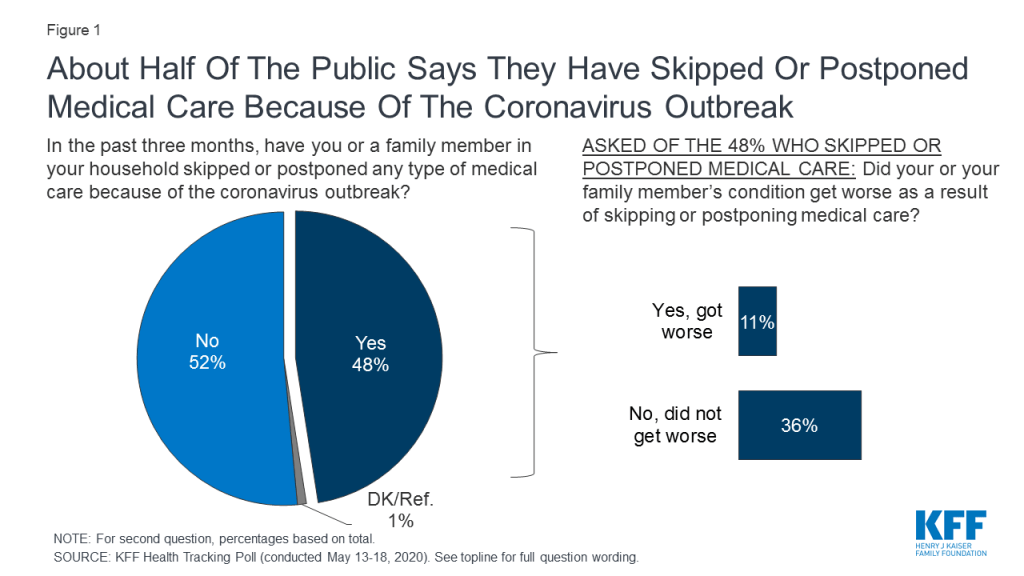
Among those who say they or a family member have postponed or delayed medical care because of coronavirus, almost all say they will eventually get the care that has been postponed, including 68% (32% of adults overall) who expect to get the care within the next 3 months.

Despite nearly half of adults saying that they or a member of their household has deferred medical care due to coronavirus, most adults (86%) and at least eight in ten across age groups, say their physical health has “stayed about the same” since the outbreak began. Few adults say their physical health has gotten better (6%) and a similar share say their physical health has gotten worse (8%) since the coronavirus outbreak began in the U.S.
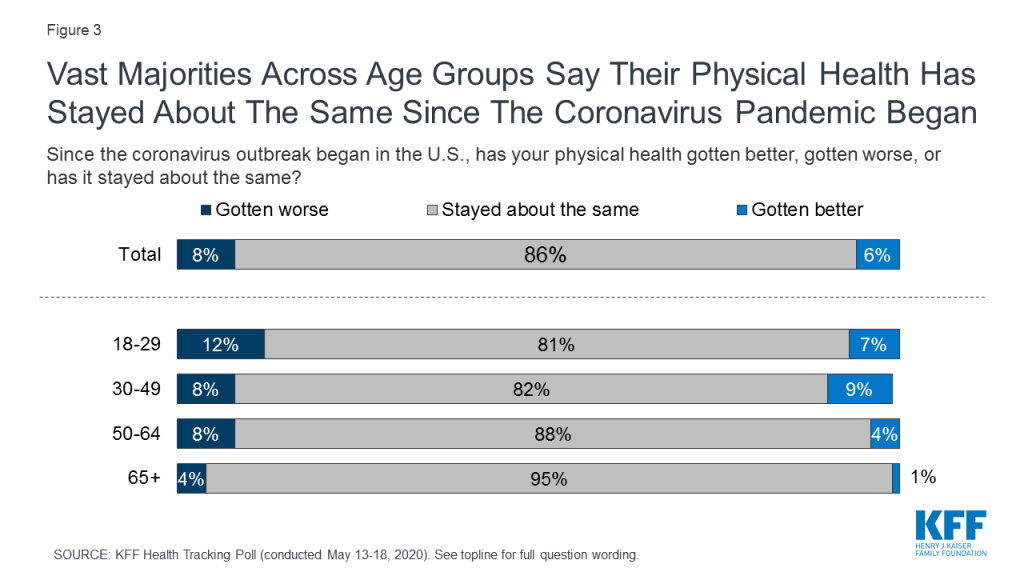
Though few Americans say their physical health has worsened, nearly four in ten (39%) say that worry or stress related to coronavirus has had a negative effect on their mental health. The share of adults who say coronavirus has had a “major” impact on their mental health (12%) has decreased slightly from early April (19%).
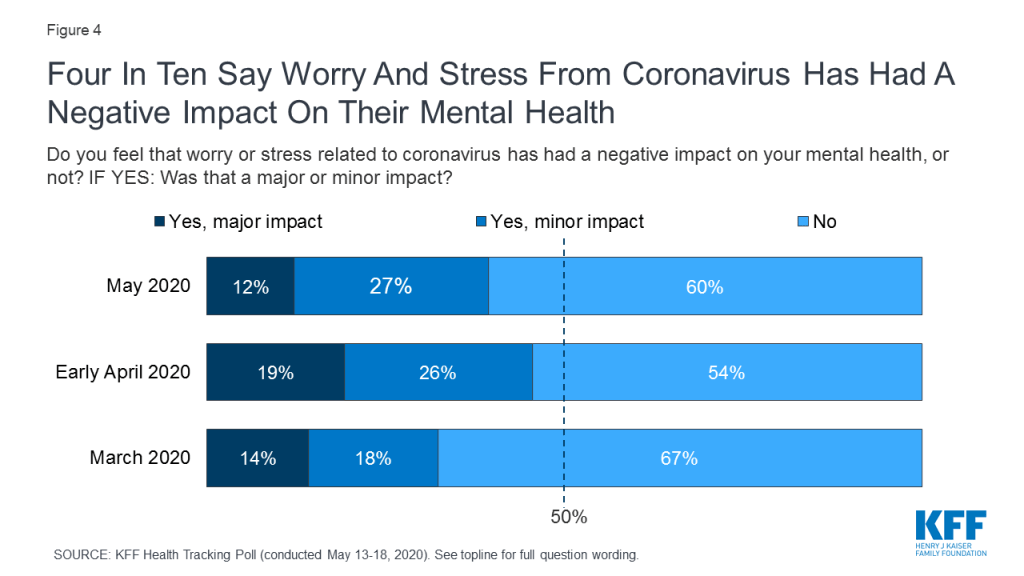
Consistent with findings in our earlier surveys, women continue to be more likely than men to say coronavirus has had a negative impact on their mental health (46% vs 33%). Similarly, those who live in urban (46%) and suburban (38%) areas are more likely than those who live in rural areas (28%) to say coronavirus has had a negative impact on their mental health. Among those living in households that experienced income or job loss since the coronavirus outbreak, 46% say the pandemic has had a negative impact on their mental health, including 13% who say it has had a “major impact.”
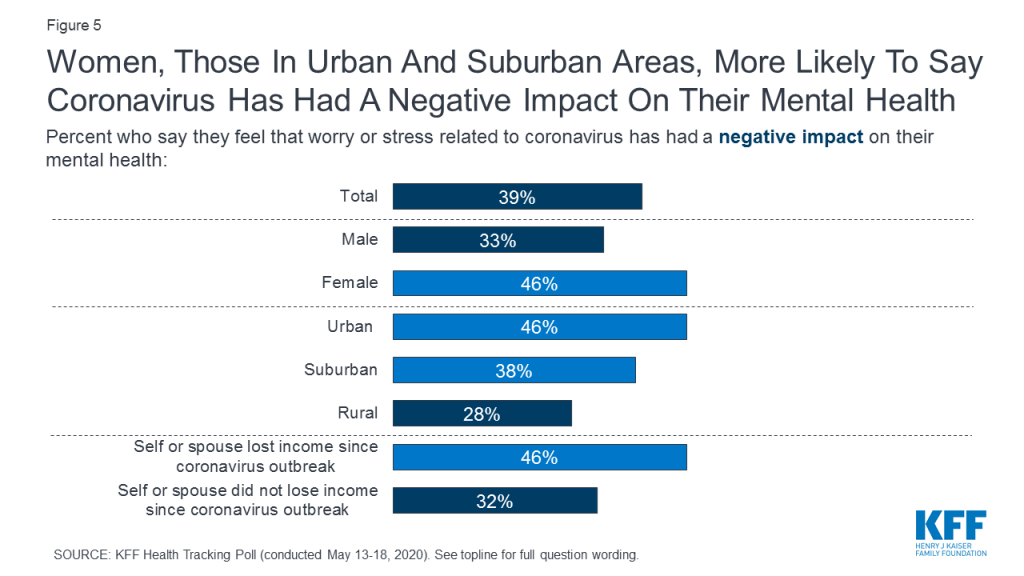
One In Four U.S. Adults Say Their Families Have Skipped Meals Or Relied On Charity Or Government Food Programs Since The Coronavirus Outbreak Began
As the economic downturn continues, about three in ten adults (31%) have had difficulty paying household expenses, including about one in six who say they have fallen behind in paying credit card or other bills (18%), have had problems paying their utilities (17%), or fallen behind in paying their rent or mortgage (15%) since the coronavirus outbreak in the U.S. began. An additional 13% say they have had problems paying for food while about one in ten say they have had problems affording their health insurance coverage (9%) or their prescription medications (8%) or have had problems paying medical bills (11%). Among those living in households that experienced a job loss or had their income reduced due to the coronavirus outbreak, about half (49%) have had difficulty paying household expenses as a result. This includes about a third who say they have had problems paying credit cards bill (34%) or utilities (31%), 28% who say they have fallen behind on their rent or mortgage, and about one in four who say they have had trouble paying medical bills (23%) or affording food (23%).
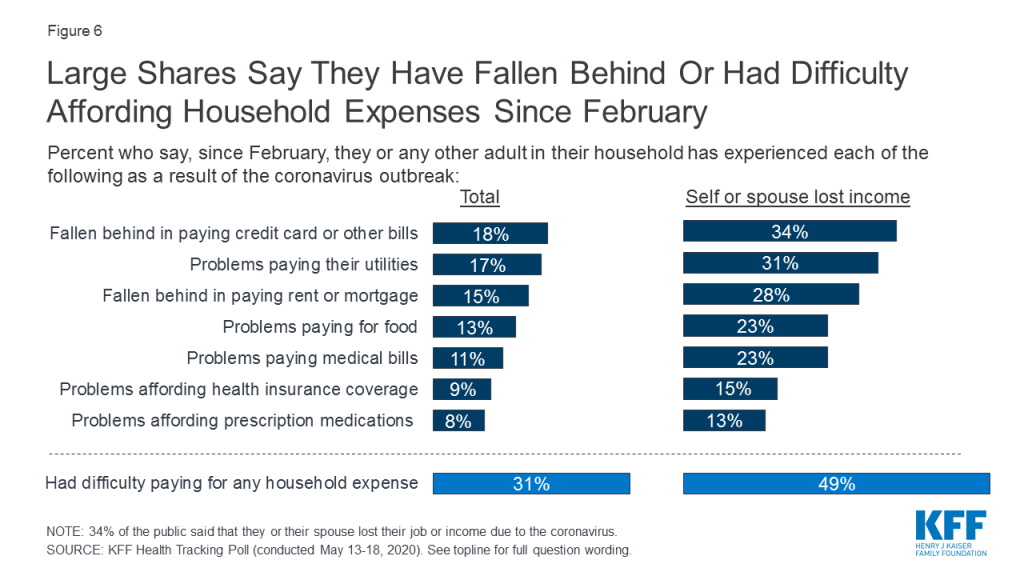
One in four Americans (26%) say they or a member of their household have skipped meals or relied on charity or government food programs since February, including 14% who say they have reduced the size of meals or skipped meals because there wasn’t enough money for food, 13% who have visited a food bank or pantry for meals, and 13% who have applied for or received SNAP benefits.
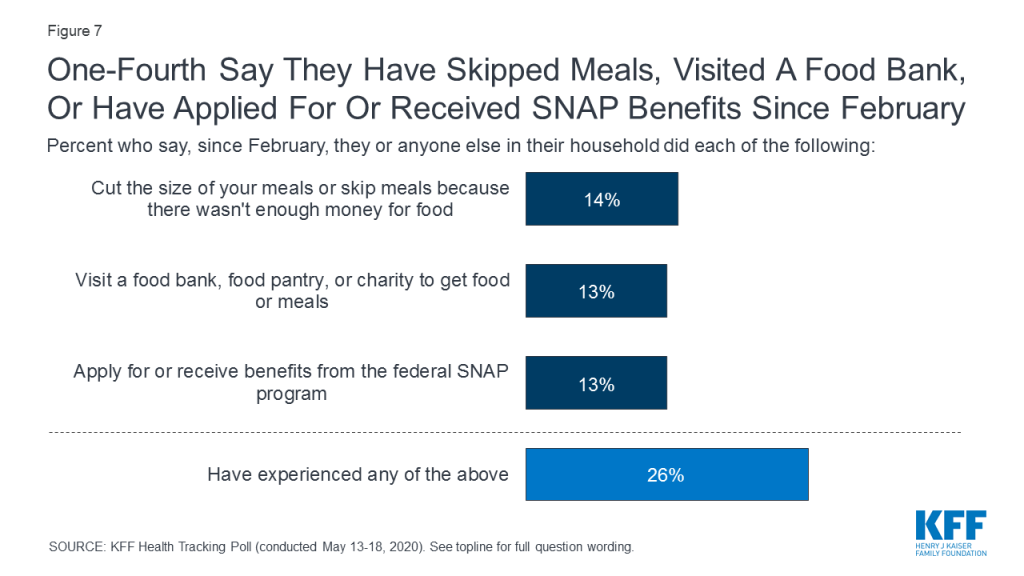
Overall, one in six Americans say that their experiences skipping meals or relying on charity or government food programs was because of coronavirus and its impact on their financial situation. A further 10% say they were already experiencing problems affording food before the coronavirus outbreak.
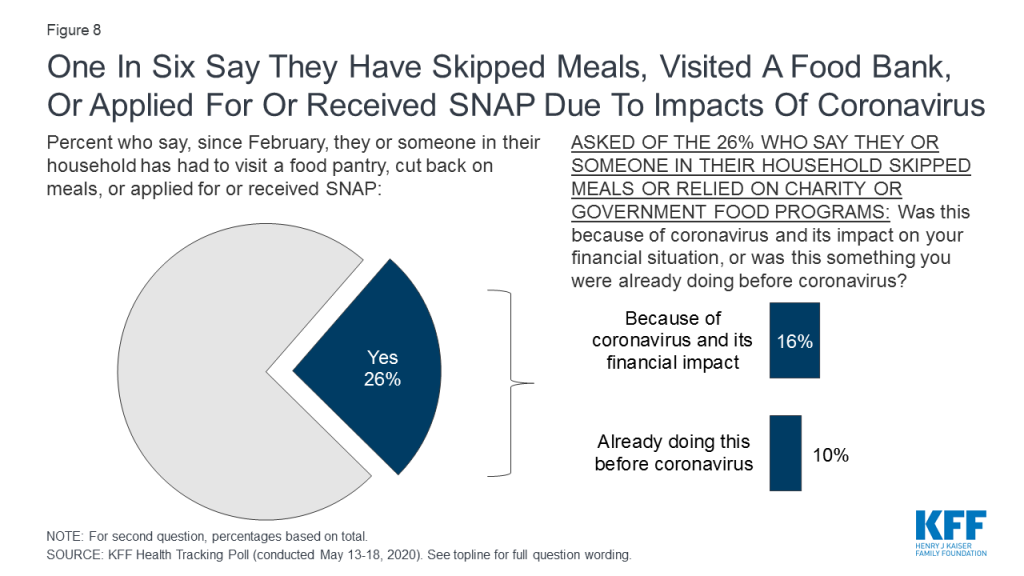
Some groups are more likely than others to report difficulty affording food as a result of coronavirus. About a third (34%) of all adults say they or their spouse lost a job or had their hours or income reduced as a result of the coronavirus outbreak. Among this group, about four in ten (38%) say they have skipped meals or relied on charity or government food programs since February, most of whom (30%) say coronavirus was the cause.
In addition, Black and Latino adults and those with lower incomes appear to be harder hit. About four in ten Black adults (45%) and Latinos (39%) say they have skipped meals or relied on charity or government food programs since February, including three in ten Black adults and about a quarter (26%) of Hispanics who say their experiences were directly related to the financial impact of coronavirus. Among those in households with an annual income under $40,000, nearly half (48%) say they have skipped meals or relied on charity or government food programs, including one-quarter who attribute this to coronavirus and a similar share (23%) who say they were already skipping meals or relying on food programs before the pandemic hit.
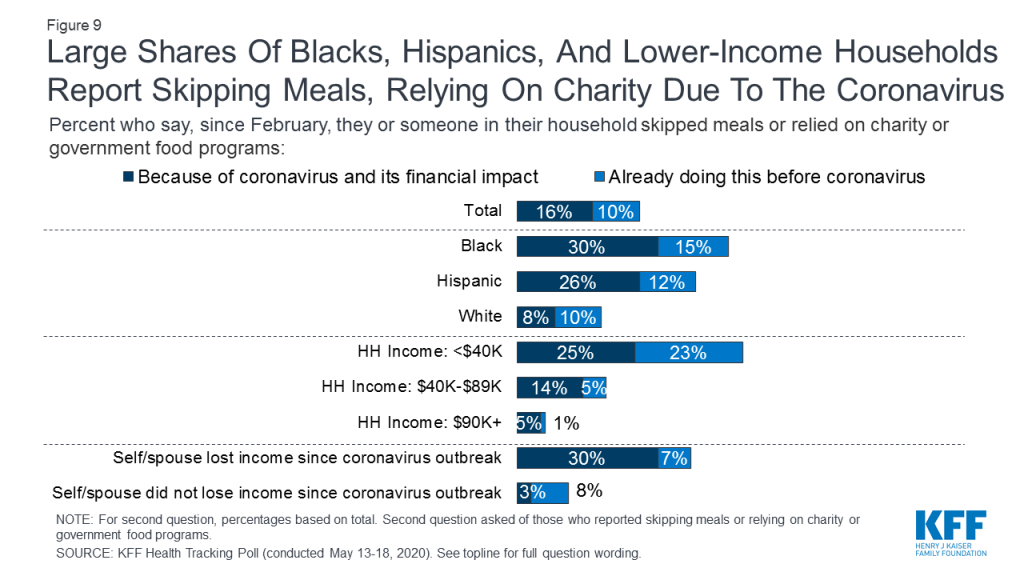
| Table 1: Skipping Meals Or Relying On Charity Or Government Food Programs By Demographic Groups | |||||||||
| Percent who say they or someone in their household has done each of the following since February: | Total | Race/ethnicity | Household income | HH lost job/income due to coronavirus | |||||
| Black | Hispanic | White | <$40K | $40 to <$90K | $90K+ | Yes | No | ||
| Skipped or cut the size of meals because there wasn’t enough money for food | 14% | 27% | 20% | 8% | 23% | 12% | 4% | 24% | 4% |
| Visited a food bank, food pantry, or charity for food | 13 | 28 | 19 | 8 | 27 | 6 | 2 | 20 | 6 |
| Applied for or received SNAP assistance | 13 | 34 | 13 | 10 | 30 | 8 | 1 | 16 | 6 |
| NET: Yes to any item above | 26 | 45 | 39 | 18 | 48 | 19 | 7 | 38 | 11 |
| Due to coronavirus and its impact on their financial situation | 16 | 30 | 26 | 8 | 25 | 14 | 5 | 30 | 3 |
As States Face Budget Shortfalls, Public Opposes State Budget Cuts To Most Areas
Due to the recent economic downturn, many states may need to decrease spending in order to address projected budget shortfalls. Notably, eight in ten adults oppose their state government cutting spending on K-12 public education (80%) while about three in four oppose decreasing spending on police and safety (75%) and Medicaid (74%). Six in ten oppose their state government cutting spending on social services and slight majorities oppose cutting spending on higher education (55%), prisons and jail (54%), and environmental protection (54%). Notably, a majority of adults support their state decreasing spending on transportation (57%) in order to address budget shortfalls.
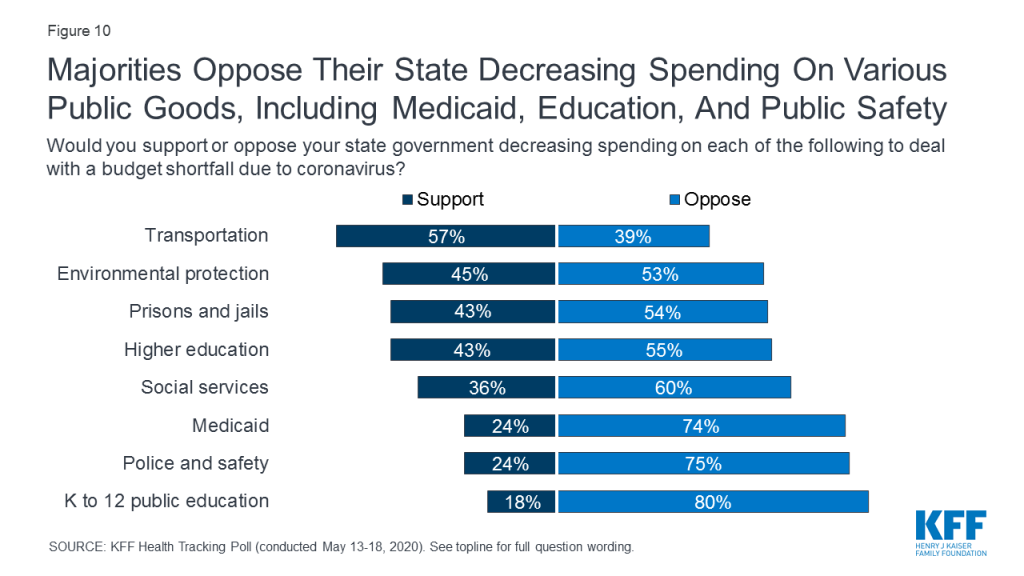
Across partisans, majorities of Democrats (85%), independents (73%), and Republicans (62%) oppose their state government decreasing spending on Medicaid. Similarly, majorities across partisans oppose decreasing spending on K-12 public education and on police and safety. Partisan splits are larger when it comes to state spending on higher education, social services, environmental protection.
| Table 2: Majorities across partisans oppose their state government decreasing funding for K-12 education, police, and Medicaid | |||
| Percent who oppose their state government decreasing spending on each of the following: | Democrats | Independents | Republicans |
| K-12 public education | 89% | 79% | 76% |
| Police and safety | 71 | 72 | 91 |
| Medicaid | 85 | 73 | 62 |
| Higher education | 72 | 47 | 43 |
| Social services | 70 | 58 | 46 |
| Prisons and jails | 53 | 54 | 53 |
| Environmental protection | 73 | 47 | 37 |
| Transportation | 44 | 39 | 35 |
With the sudden rise in unemployment following the coronavirus outbreak, many Americans have not only lost their jobs, but have also lost the health insurance coverage provided by their former employers. A recent KFF analysis estimates that since the coronavirus outbreak began in the U.S., nearly half of adults who lost their health insurance coverage due to job loss are eligible for Medicaid, the government health insurance and long-term care program for low-income adults and children,.
A majority of Americans (55%) say the Medicaid program is important to them and their family including 37% who say it is “very important”. Seven in ten adults with a household income under $40,000 (71%) say Medicaid is important to them and their family. Across partisans, Democrats (65%) and independents (54%) are more likely than Republicans (40%) to say Medicaid is important to them.
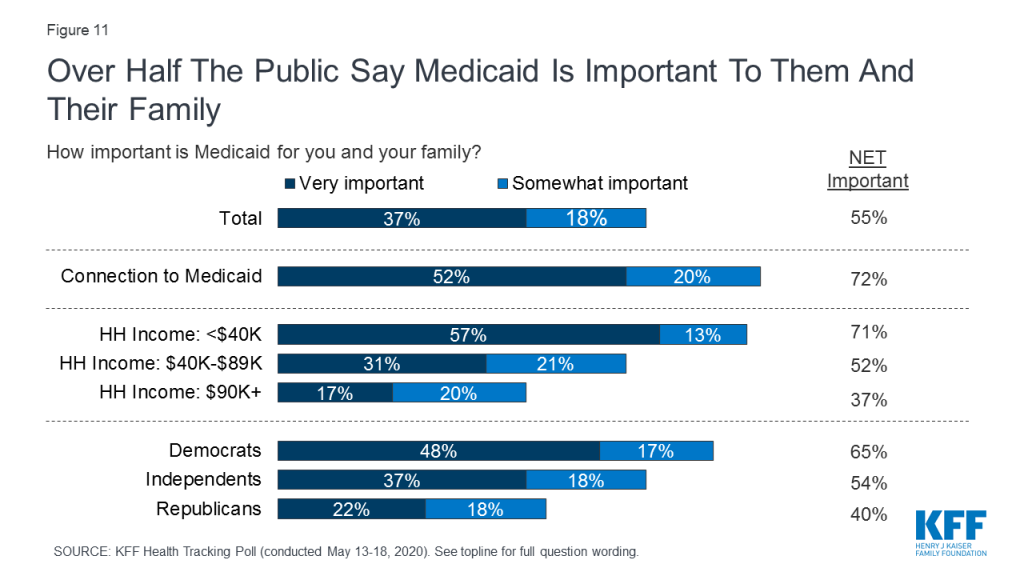
Amid rising unemployment, about one in four (23%) adults who are not currently covered by Medicaid say they or a family member are likely to rely on Medicaid for health care coverage in the next year. Notably, about four in ten (38%) adults with a household income under $40,000 who are not currently on Medicaid, say it is very or somewhat likely that they or someone in their household will turn to Medicaid in the next year. Among households who have lost income due to the coronavirus outbreak, 31% say it is very or somewhat likely that they will turn to Medicaid for health insurance coverage in the next year.
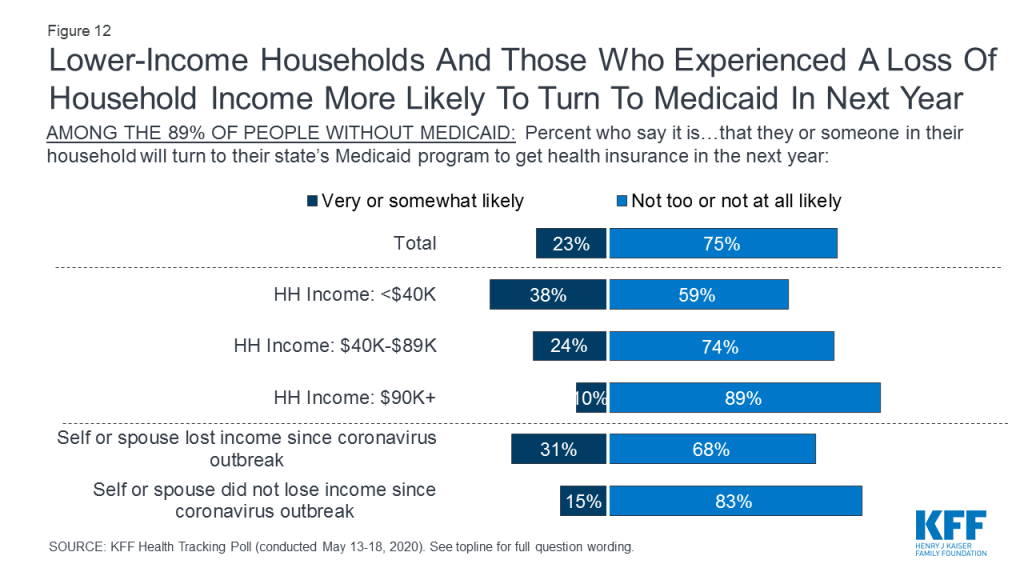
Under the 2010 Affordable Care Act (ACA), a number of states have expanded their Medicaid program. Among those who live in the 14 states that have not yet expanded their Medicaid program, two-thirds (66%) say they want their state to expand Medicaid to cover more low-income uninsured people, while about one-third (32%) want to keep Medicaid as it is today. However, within these states that have not yet expanded Medicaid, there is a large partisan gap on this issue with 89% of Democrats and 72% of independents preferring their state expand the program to cover more low-income uninsured people, while a majority of Republicans (58%) prefer to keep Medicaid in their state as it is now. In states that have not expanded their Medicaid programs, seven in ten adults whose household experienced a job or income loss due to coronavirus say their state should expand the program, while fewer adults who have not experienced a job or income loss say the same (72% vs. 52%).
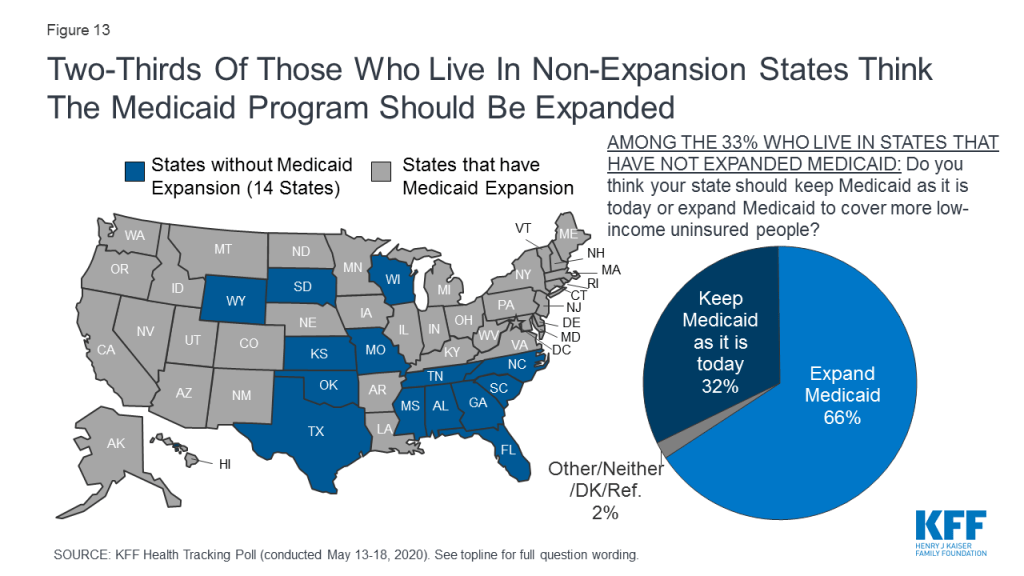
2010 Affordable Care Act
The most recent KFF Health Tracking Poll finds about half of the public (51%) have a favorable view of the ACA while 41% view it unfavorably, similar to the split in opinion since 2019. A majority of Republicans (76%) continue to hold unfavorable views towards the law, while eight in ten Democrats (80%) and a majority of independents (55%) hold favorable views of the ACA.
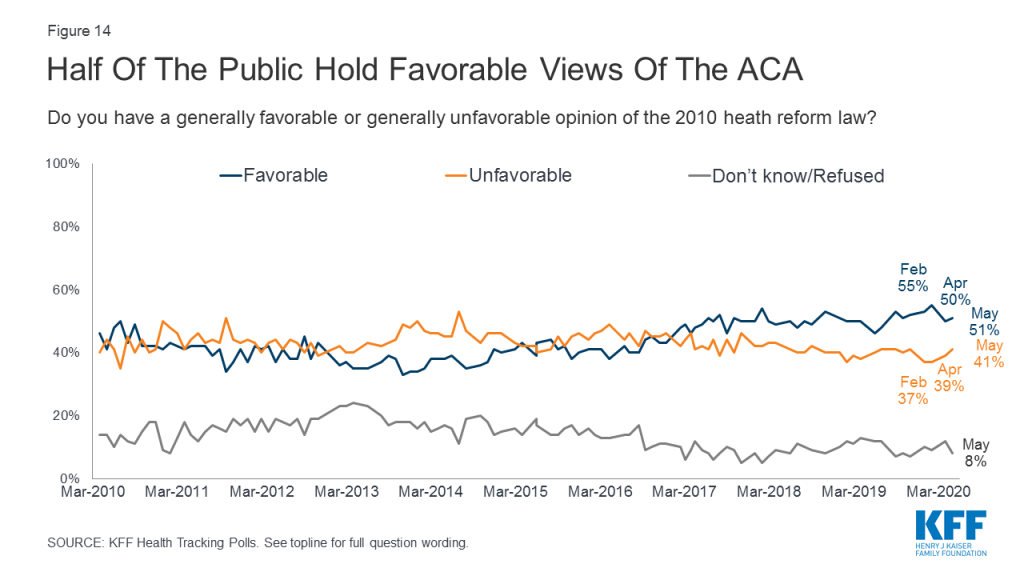
Medicare-for-all and Public Option
Though the 2020 Democratic presidential primary campaign has largely concluded, the policy discussions on the how to best expand public health insurance in this country have continued as the nation faces a deadly public health crisis. KFF continues to track public opinion on both a national health plan, sometimes called Medicare-for-all, as well as more incremental changes such as an optional government-administered health plan, sometimes called a public option. A majority (56%) of the public favors a Medicare-for-all plan in which all Americans would get their insurance from a single government plan (41% oppose), though a government administered public option continues to garner more support with two-thirds (68%) in favor a public option that would compete with private health plans and be available to all Americans (28% oppose).
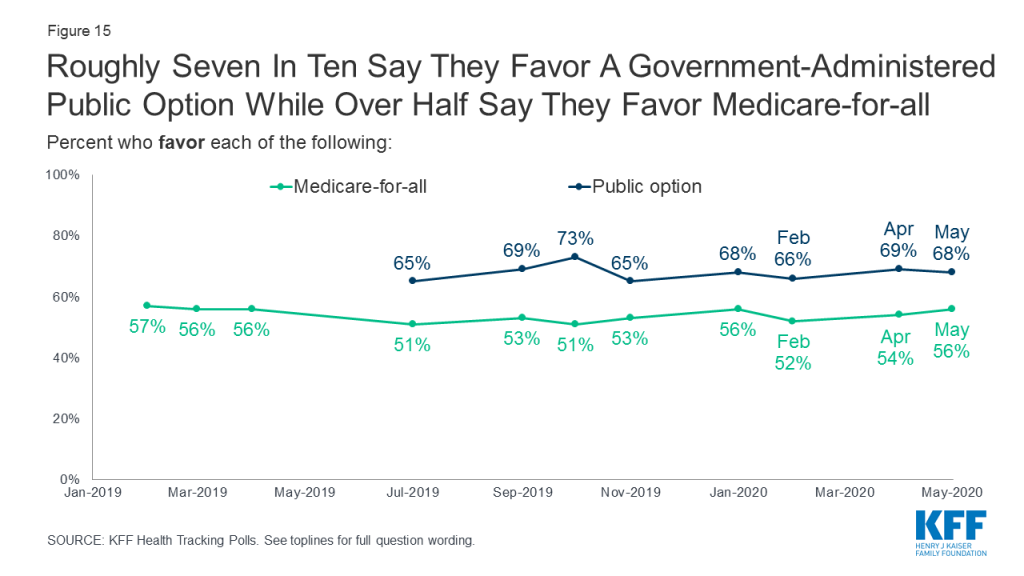
Large majorities of Democrats favor both Medicare-for-all (78%) and a public option (84%), as do majorities of independents (60% favor Medicare-for-all, 70% favor a public option). Among Republicans, one in four (24%) support a national Medicare-for-all plan while more than four in ten (44%) favor a public option.
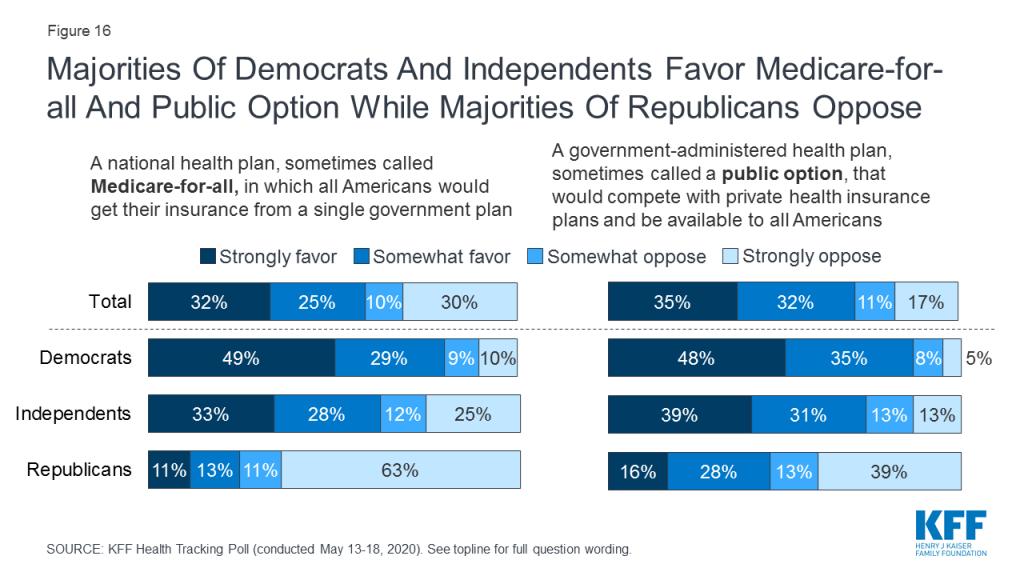
Endnotes
1 “During a Pandemic, an Unanticipated Problem: Out-of-Work Health Workers”. New York Times (April 3, 2020). https://www.kff.org/report-section/kff-health-tracking-poll-late-april-2020-economic-and-mental-health-impacts-of-coronavirus/
2 “Thousands of healthcare workers are laid off or furloughed as coronavirus spreads”. Los Angeles Times (May 2, 2020). https://www.latimes.com/california/story/2020-05-02/coronavirus-california-healthcare-workers-layoffs-furloughs
Methodology
This KFF Health Tracking Poll was designed and analyzed by public opinion researchers at the Kaiser Family Foundation (KFF). The survey was conducted May 13th – 18th, 2020, among a nationally representative random digit dial telephone sample of 1,189 adults ages 18 and older, living in the United States, including Alaska and Hawaii (note: persons without a telephone could not be included in the random selection process). The sample included 290 respondents reached by calling back respondents that had previously completed an interview on the KFF Tracking poll at least nine months ago. Computer-assisted telephone interviews conducted by landline (283) and cell phone (906, including 634 who had no landline telephone) were carried out in English and Spanish by SSRS of Glen Mills, PA. To efficiently obtain a sample of lower-income and non-White respondents, the sample also included an oversample of prepaid (pay-as-you-go) telephone numbers (25% of the cell phone sample consisted of prepaid numbers) as well as a subsample of respondents who had previously completed Spanish language interviews on the SSRS Omnibus poll (n=9). Both the random digit dial landline and cell phone samples were provided by Marketing Systems Group (MSG). For the landline sample, respondents were selected by asking for the youngest adult male or female currently at home based on a random rotation. If no one of that gender was available, interviewers asked to speak with the youngest adult of the opposite gender. For the cell phone sample, interviews were conducted with the adult who answered the phone. KFF paid for all costs associated with the survey.
The combined landline and cell phone sample was weighted to balance the sample demographics to match estimates for the national population using data from the Census Bureau’s 2018 American Community Survey (ACS) on sex, age, education, race, Hispanic origin, and region along with data from the 2010 Census on population density. The sample was also weighted to match current patterns of telephone use using data from the July-December 2018 National Health Interview Survey. The weight takes into account the fact that respondents with both a landline and cell phone have a higher probability of selection in the combined sample and also adjusts for the household size for the landline sample, and design modifications, namely, the oversampling of prepaid cell phones and likelihood of non-response for the re-contacted sample. All statistical tests of significance account for the effect of weighting.
The margin of sampling error including the design effect for the full sample is plus or minus 3 percentage points. Numbers of respondents and margins of sampling error for key subgroups are shown in the table below. For results based on other subgroups, the margin of sampling error may be higher. Sample sizes and margins of sampling error for other subgroups are available by request. Note that sampling error is only one of many potential sources of error in this or any other public opinion poll. Kaiser Family Foundation public opinion and survey research is a charter member of the Transparency Initiative of the American Association for Public Opinion Research.
| Group | N (unweighted) | M.O.S.E. |
| Total | 1,189 | ± 3 percentage points |
| Party Identification | ||
| Democrats | 366 | ± 6 percentage points |
| Republicans | 326 | ± 6 percentage points |
| Independents | 386 | ± 6 percentage points |
| Registered Voters | ||
| Total | 970 | ± 4 percentage points |
| Swing | 320 | ± 7 percentage points |